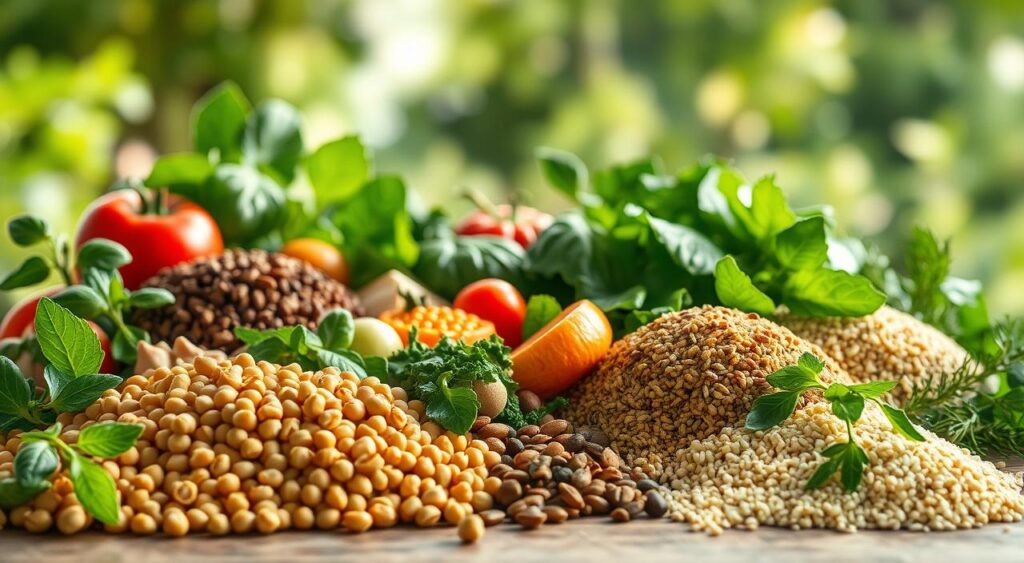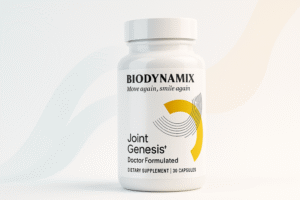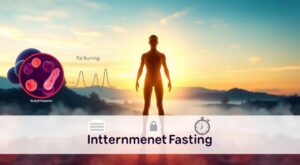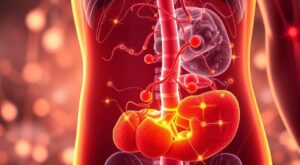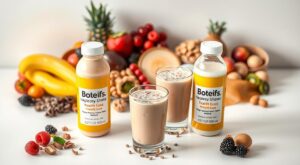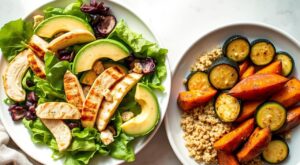Have you thought about how plant-based protein could change your health? More Americans are seeing the benefits of vegan protein sources. A well-planned vegetarian or vegan diet can give you all the nutrients you need, including protein.
In this guide, you’ll learn about the many benefits of plant protein. You’ll also find out the best sources to add to your meals. Plus, you’ll get tips on how to make these ingredients a part of your daily life.
If you’re looking for a healthier lifestyle or want to try sustainable options, learning about plant-based protein is key. For more information, check out this article on plant-based protein.
Understanding Plant-Based Protein
Plant-based protein comes from many sources like legumes, grains, nuts, and seeds. It’s different from animal proteins, which often have a lot of saturated fat and cholesterol. Plant proteins usually have less unhealthy fats and no cholesterol.
Some people worry about getting enough protein on a plant-based diet. But many experts say you can get enough protein from a variety of whole foods.
To understand the benefits of vegetarian protein options, it’s key to know plants can give all the amino acids your body needs. When you mix different plants, like beans with grains or nuts with legumes, you get all the amino acids your body needs.
Adding non-dairy protein sources to your meals can bring many health benefits. If you want to learn how to get enough protein from plant-based meals, check out the vegan protein guide. Choosing plant-based proteins can help you nourish your body and improve your overall health.
Health Benefits of a Plant-Based Diet
Switching to a plant-based diet brings many health perks. It can make you feel better overall. Eating more plant proteins is good for your health.
Plant protein foods are not just good for you. They also help prevent chronic diseases.
Reducing the Risk of Chronic Diseases
A plant-based diet can lower the risk of heart disease, diabetes, and some cancers. It’s great for your heart. Eating less red meat and more fruits, veggies, and whole grains is key.
This diet can also help control blood pressure and cholesterol.
Enhancing Longevity and Reducing Morbidity
Choosing a plant-based diet is more than avoiding bad foods. It’s about adding nutrition that helps you live longer. Eating more plants can help you stay healthy and reduce inflammation.
This can make you live longer and feel better. It’s a way to improve your life for years.
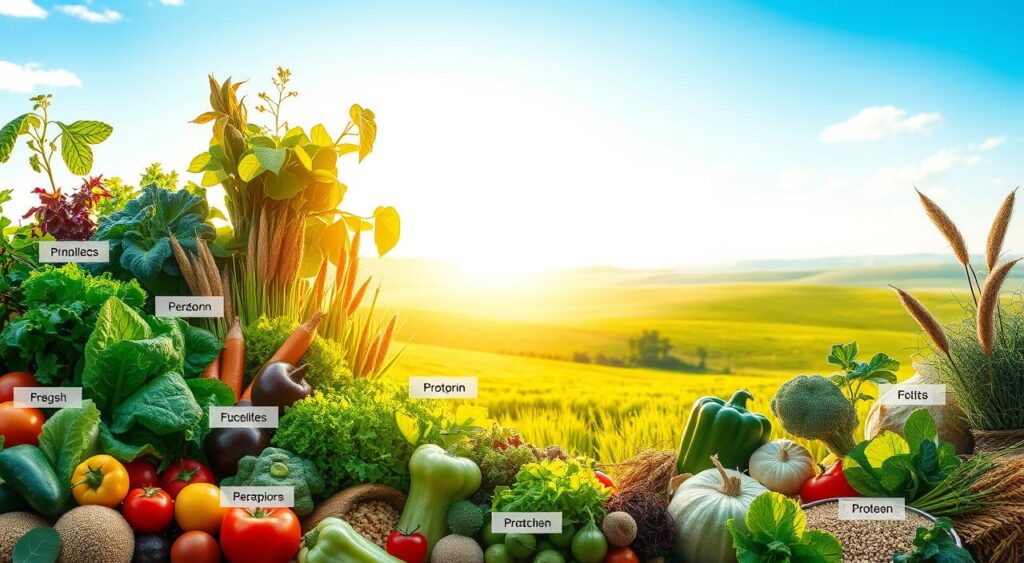
Why Choose Plant-Based Protein?
Plant-based protein has many benefits for your health. It’s rich in quality protein and essential amino acids. Even though many animal proteins are complete, you can mix plant proteins to get all the amino acids you need.
Quality of Protein and Essential Amino Acids
Plant protein benefits come from mixing different sources. Legumes, nuts, and grains together give you all essential amino acids. This mix boosts your health and gives you a variety of tastes and textures.
Fiber Content and Digestive Health
Plant proteins are also high in fiber. Foods like beans, lentils, and whole grains are great for your gut. They help control blood sugar and keep your gut healthy. Adding these to your diet can help with digestion and give you important nutrients.

Top Sources of Plant-Based Protein
Many plant foods are high in protein, making it easy to eat vegan. Knowing the best plant-based protein sources helps you make healthy meals. Let’s look at some tasty options that boost your protein and health.
Beans and Legumes
Beans and legumes are super nutritious. Lentils, chickpeas, and black beans are packed with protein and fiber. They also have vitamins and minerals. Adding them to salads, soups, or stews increases your protein and makes meals better.
Nuts and Seeds
Nuts and seeds are full of healthy fats and protein. Almonds, walnuts, chia seeds, and flaxseeds are great for your protein needs. Eating them as snacks or adding them to smoothies and baked goods is a smart way to get more protein.
Whole Grains and Ancient Grains
Whole grains like quinoa, brown rice, and farro are high in protein. Ancient grains like amaranth and spelt are also good. These grains are not only protein-rich but also full of nutrients. For more on whole grains, check out this guide.
High-Protein Vegetables
Don’t forget about high-protein veggies like broccoli, Brussels sprouts, and peas. They’re not just protein-rich but also full of vitamins and minerals. Eating a variety of these greens will make your meals more nutritious.
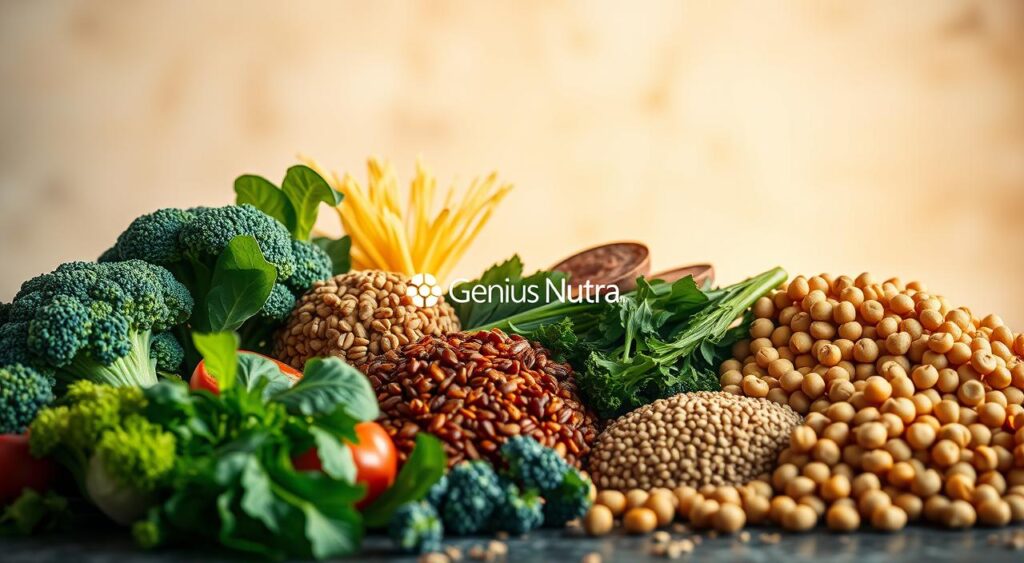
Popular Plant Protein Options to Include in Your Diet
Adding different plant proteins to your meals makes them more nutritious and tasty. Here are some top picks to boost your diet.
Pea Protein
Pea protein is loved for its easy digestion and rich amino acids. It’s a top choice for those avoiding dairy. Made from yellow peas, it’s great in smoothies, baked goods, and bars.
Soy Protein: Tofu, Tempeh, and Edamame
Soy protein is special because it has all the amino acids you need. Tofu and tempeh are not just protein-rich but also good for your heart. Edamame, young soybeans, are tasty as snacks or in salads.
Lentils and Their Versatility
Lentils are amazing for their flexibility and health benefits. They fit well in soups, stews, salads, and tacos. They’re full of protein and fiber, helping you feel full and get the nutrients you need.
Introducing Nutritional Yeast
Nutritional yeast is a game-changer for vegans. It’s packed with protein and tastes like cheese. Sprinkle it on popcorn, pasta, or in sauces for a nutritional kick. It’s a hit for making vegan cheese taste good.
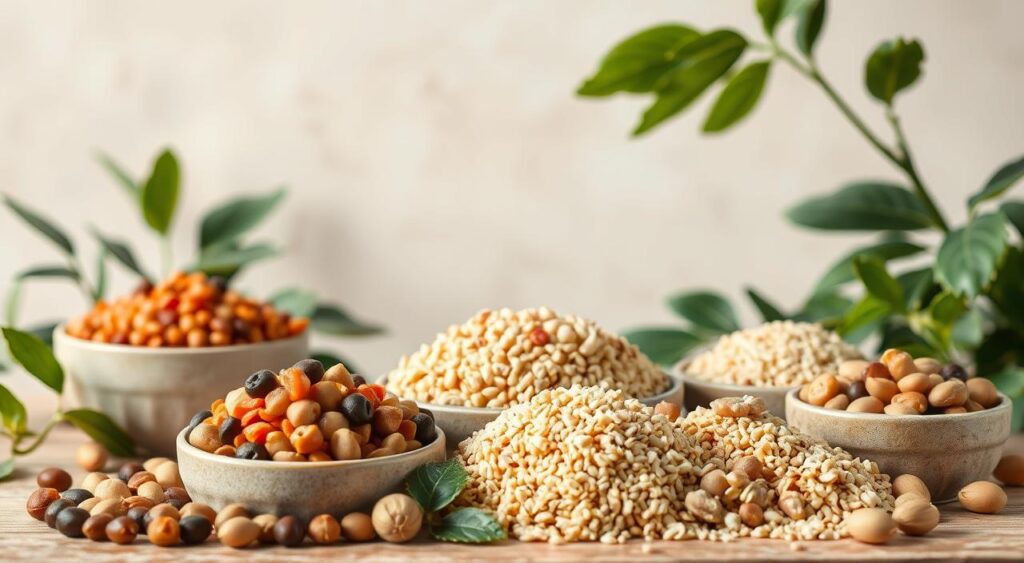
Creative Ways to Add Plant-Based Protein to Your Meals
Adding plant-based protein to your meals can make them tastier and healthier. Here are some fun ideas to make your day full of delicious, plant-based meals.
Protein-Rich Breakfast Ideas
Starting your day with a protein-rich breakfast is a great way to go. Here are some tasty options:
- Oatmeal topped with chia seeds and fresh fruit
- Smoothie packed with spinach, banana, and hemp seeds
- Avocado toast on whole grain bread with a sprinkle of nutritional yeast
Snacking on Plant-Based Options
When you get hungry, choose healthy plant protein snacks. Here are some ideas:
- Energy balls made from oats, nuts, and dates
- Popcorn sprinkled with nutritional yeast for a cheesy flavor
- Veggies and hummus for a crunchy, satisfying treat
Dinner Recipes Featuring Plant Proteins
For dinner, try recipes that focus on plant proteins. Here are some options:
- Lentil stew with spices and a side of whole grain bread
- Quinoa salad loaded with roasted vegetables and chickpeas
- Stir-fried vegetables with tofu drizzled in soy sauce
How to Transition to a Plant-Based Diet
Starting a plant-based diet can seem daunting. But with the right plan, you can easily add more plant-based foods to your life. Begin by updating your grocery list to include whole foods. This change not only boosts your health but also opens up a world of new tastes.
Adapting Your Grocery List
Your grocery list is key to this change. To make a healthy shopping list, focus on:
- Whole grains like quinoa, brown rice, and oats
- Beans and legumes such as chickpeas, lentils, and black beans
- Seasonal fruits and vegetables
- Nuts and seeds, including almonds, walnuts, and chia seeds
By using a plant-based diet grocery list, your kitchen can become a place of vibrant, healthy meals. These meals will keep you full of energy and well.
Cooking Techniques for Plant-Based Meals
Trying new cooking methods is essential for keeping your meals interesting. Consider using:
- Batch cooking to save time during busy weekdays
- Meal prepping to plan and portion your meals in advance
- Using spices and herbs to enhance flavors, making plant-based dishes appealing
Enjoying cooking can make your plant-based diet journey fun and fulfilling. Start with simple recipes using your grocery list ingredients. This will help you build confidence in the kitchen.
Addressing Common Concerns About Plant-Based Proteins
Many people worry about getting enough protein when they switch to a plant-based diet. They often ask if a vegan diet can provide enough protein. Eating a variety of plant-based foods like beans, lentils, nuts, and whole grains can help meet protein needs.
Getting Enough Protein on a Vegan Diet
It’s easy to get enough protein on a vegan diet with the right plan. Experts recommend eating a variety of protein-rich foods. This ensures you get all the amino acids your body needs. Foods like quinoa, chickpeas, and spirulina are great for adding protein to your meals.
Supplementing with High-Quality Protein Powders
If you need extra protein, plant-based supplements can be a good choice. High-quality options like pea protein and brown rice protein can fill nutritional gaps. They’re great for those with special dietary needs or who are very active. Always talk to a healthcare provider before adding supplements to your diet.
| Protein Source | Protein Content (per 100g) | Amino Acids | Notes |
|---|---|---|---|
| Quinoa | 14g | Complete protein | Gluten-free, rich in nutrients |
| Chickpeas | 9g | Good range of essential amino acids | Versatile for various dishes |
| Brown Rice Protein | 24g | Low in lysine | Popular in protein supplements |
| Pea Protein | 25g | Rich in BCAAs | Great for muscle synthesis |
Conclusion
Choosing plant-based protein makes your meals better and boosts your health. You’ll find many tasty options to add to your diet. Beans and grains are just the start, each with its own health benefits.
Learning about plant-based diets helps you improve your health. You might choose to eat more plant proteins or switch fully. Every meal is a chance to feed your body well and enjoy the food.
Starting to eat more plant proteins is rewarding and good for the planet. You’ll love the new tastes and textures. Your health will get better, and you’ll feel great about your choices.

